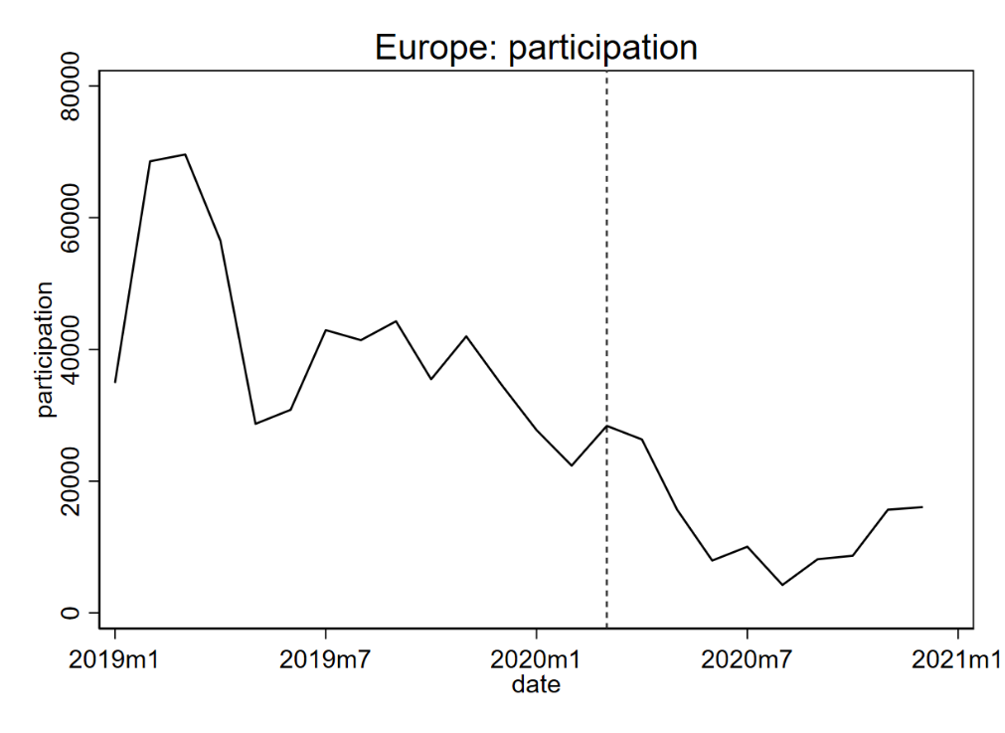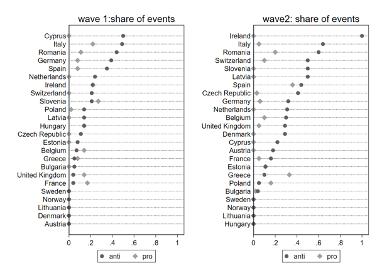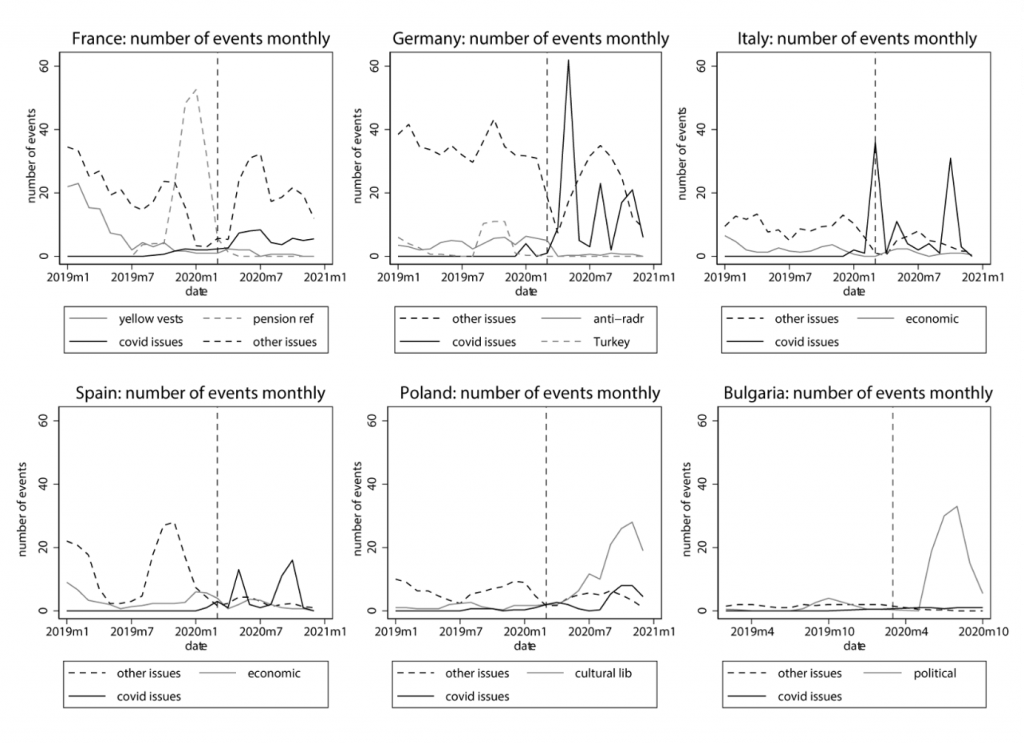Ioana-Elena Oana and Hanspeter Kriesi
Based on a Research Article by Ioana-Elena Oana and Hanspeter Kriesi
Full publication: ‘Protest in unlikely times: dynamics of collective mobilization in Europe during the COVID-19 crisis’, Journal of European Public Policy https://doi.org/10.1080/13501763.2022.2140819
While political protest is usually rare and highly unequally distributed across time and space, crisis periods are often considered to have a unique activation potential through the uncertainty they bring about and the grievances they create. The COVID crisis constitutes a unique opportunity to study the impact of public policy on collective public protest. While the governments’ lockdown measures provided an incentive to protest by increasing grievances, they also constrained the opportunities to do so in the streets, hence making it, at face value, rather unlikely.
In a paper published in Journal of European Public Policy, we set out to examine the extent and nature of protest across 30 European countries in the Covid crisis in 2020 by means of an original PEA dataset covering virtually all forms of protest taking place in the streets and reported in the media. This data enabled us to shed light on three main aspects of protest during COVID: the impact of lockdowns, the nature of Covid-related protest in terms of their pro- or anti-restriction orientation, and the extent to which other, non-Covid related protest continued or was crowded out across European regions.
The impact of the lockdown on protest in general
Our first set of findings shows that, as a consequence of these lockdown measures, protest was, indeed, reduced during the Covid-19 crisis but was hardly brought to a halt.
Figure 1 presents the development of protest overall across Europe during the years 2019 and 2020 for two indicators – the number of protest events (a) and for the average number of participants per protest events (b). The dashed vertical line in the graphs indicates the beginning of the crisis in March 2020 (when the first lockdown measures started being adopted across Europe). The number of protest events initially precipitously declined as Europe was in a state of shock which paralyzed the countries also in terms of protest. Nevertheless, the number of protests soon picked up again, peaking in summer 2020. However, though by no means interrupted, protest occurred at significantly lower levels compared to pre-Covid-19 times in terms of number of events and, above all, in terms of the number of participants.


Beyond these descriptive measures of the levels of protest, we also attempted to systematically account for the increase in Covid-related protest and the decline of protest on other issues by introducing two measures characterizing the situation in a given country – the stringency of the lockdown measures adopted by the governments and the pandemic pressure operationalized by infection rates and confirmed COVID-19 mortality rates adjusted by country size. Our results indicate that the more stringent the lockdown measures in that particular week, the more numerous Covid-related protest. As Covid-related protest was primarily anti-restriction protest, it is obvious that it reacted to the stringency of the lockdown measures in the same week. Conversely, the higher the infection and mortality rates, the less frequent is protest on other, non-Covid issues in the same week.
The mobilization of Covid-related protest
Our second set of results shows that protest was refocused on Covid-19-related issues, and, in particular, on protest against the restrictions imposed by the government lockdowns. Figure 2 shows that anti-restriction protest surpassed levels of pro-restriction protest across almost all countries and intensified as the pandemic dragged on, as the opponents of restrictions had greater incentives to protest than supporters of restrictions, and were more ready to trespass rules.

The mobilization of other, non-Covid-related protest
Finally, our study shows that non-Covid-19 issues, in particular economic issues and (especially in the UK) issues related to the EU, were crowded out, but at differential levels in the three regions of Europe. Specifically, protest targeting non-Covid-19-related issues were reduced to a greater extent in southern Europe than in the other two regions. However, non-Covid-19 protest also responded to highly contingent national context conditions. As Figure 3 shows, in north-western Europe, issues related to cultural liberalism have come to dominate protest in the first wave as a consequence of the spillover of the Black-Lives-Matter movement to Europe, and environmental issues have become somewhat more important during the second wave in reaction to the renewed mobilization by Fridays for Future. In eastern Europe, non-Covid related protest was mostly focused on domestic political issues, particularly on corruption, but also on the very restrictive abortion law in Poland. By contrast, southern Europe, as the hardest hit region in the period under study, experienced the demobilization of all other types of protest except for Covid-related ones.

All in all, our study shows that, despite its unlikeliness due to lockdowns and social distancing measures, protest during Covid-19 has hardly been put to a halt. On the one hand, goals of protest observed in pre-pandemic times have continued to be the focus of mobilization to varying extents across Europe, depending on the stringency of lockdowns, the pandemic pressure, and other country-specific factors. On the other hand, the Covid-19 crisis had its own mobilization potential bringing about a new set of issues to the fore. In this respect, our results show that anti-restrictions actions came to dominate much of the protest in the streets in 2020.